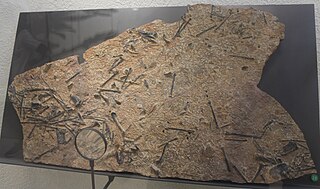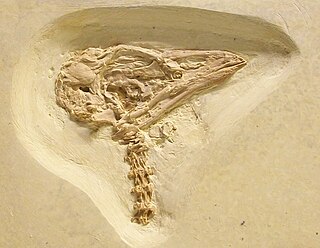
The Gruiformes are an order containing a considerable number of living and extinct bird families, with a widespread geographical diversity. Gruiform means "crane-like".

Anseriformes is an order of birds also known as waterfowl that comprises about 180 living species of birds in three families: Anhimidae, Anseranatidae, and Anatidae, the largest family, which includes over 170 species of waterfowl, among them the ducks, geese, and swans. Most modern species in the order are highly adapted for an aquatic existence at the water surface. With the exception of screamers, males have penises, a trait that has been lost in the Neoaves. Due to their aquatic nature, most species are web-footed.

Gastornis is an extinct genus of large, flightless birds that lived during the mid-Paleocene to mid-Eocene epochs of the Paleogene period. Fossils have been found in Europe, Asia and North America, with the North American specimens formerly assigned to the genus Diatryma.

Presbyornis is an extinct genus of presbyornithid bird from North America during the Paleogene period, between the Late Paleocene and Early Eocene.

Presbyornithidae is an extinct group of birds found in North America, South America, East Asia, Australia and possibly North Africa. They had evolved by the Maastrichtian age of the Late Cretaceous and became extinct during the Aquitanian age of the Early Miocene. The family contains the oldest known neognath, Teviornis from the Nemegt Formation of Mongolia.
Polarornis is a genus of prehistoric bird, possibly an anserimorph. It contains a single species Polarornis gregorii, known from incomplete remains of one individual found on Seymour Island, Antarctica, in rocks which are dated to the Late Cretaceous.
Anatalavis is genus of prehistoric birds related to ducks and geese, perhaps to the magpie-goose in particular. Alternatively, it might have been a more basal lineage of Anserimorphae distinct from the living waterfowl, similar or even related to the roughly contemporary Conflicto antarcticus from the Danian of Antarctica.
Paleontology or palaeontology is the study of prehistoric life forms on Earth through the examination of plant and animal fossils. This includes the study of body fossils, tracks (ichnites), burrows, cast-off parts, fossilised feces (coprolites), palynomorphs and chemical residues. Because humans have encountered fossils for millennia, paleontology has a long history both before and after becoming formalized as a science. This article records significant discoveries and events related to paleontology that occurred or were published in the year 1976.
Paleontology or palaeontology is the study of prehistoric life forms on Earth through the examination of plant and animal fossils. This includes the study of body fossils, tracks (ichnites), burrows, cast-off parts, fossilised feces (coprolites), palynomorphs and chemical residues. Because humans have encountered fossils for millennia, paleontology has a long history both before and after becoming formalized as a science. This article records significant discoveries and events related to paleontology that occurred or were published in the year 1973.
Paleontology or palaeontology is the study of prehistoric life forms on Earth through the examination of plant and animal fossils. This includes the study of body fossils, tracks (ichnites), burrows, cast-off parts, fossilised feces (coprolites), palynomorphs and chemical residues. Because humans have encountered fossils for millennia, paleontology has a long history both before and after becoming formalized as a science. This article records significant discoveries and events related to paleontology that occurred or were published in the year 1970.

Odontopteryx is a genus of the extinct pseudotooth birds or pelagornithids. These were probably rather close relatives of either pelicans and storks, or of waterfowl, and are here placed in the order Odontopterygiformes to account for this uncertainty.
Pseudodontornis is a rather disputed genus of the prehistoric pseudotooth birds. The pseudotooth birds or pelagornithids were probably rather close relatives of either pelicans and storks, or of waterfowl, and are here placed in the order Odontopterygiformes to account for this uncertainty. Up to five species are commonly recognized in this genus.

Juncitarsus is an extinct genus of wading birds from the Eocene of the United States and Germany. Though previously considered a flamingo, it is likely a stem-flamingo, possibly a relative of the group which contains both flamingos and grebes (Mirandornithes).

Branta rhuax, the giant Hawaiʻi goose, is an extinct goose endemic to the island of Hawaiʻi. It was initially described as the monotypic genus Geochen, but then reassigned to Branta by Storrs L. Olson in 2013 after reexamination of the subfossil material.
Phasmagyps, is an extinct genus of New World vulture in the family Cathartidae, known from one Oligocene fossil found in Colorado. The genus contains a single described species, Phasmagyps patritus which is possibly the oldest New World vulture known, though its placement in the family Cathartidae has been questioned.

Bathornithidae is an extinct family of birds from the Eocene to Miocene of North America. Part of Cariamiformes, they are related to the still extant seriemas and the extinct Phorusrhacidae. They were likely similar in habits, being terrestrial, long-legged predators, some of which attained massive sizes.

Bathornis is an extinct lineage of birds related to modern day seriemas, that lived in North America about 37–20 million years ago. Like the closely related and also extinct phorusrhacids, it was a flightless predator, occupying predatory niches in environments classically considered to be dominated by mammals. It was a highly diverse and successful genus, spanning a large number of species that occurred from the Priabonian Eocene to the Burdigalian Miocene epochs.

Vegaviidae is an extinct family of birds of uncertain phylogenetic placement, which existed during the Late Cretaceous and possibly the Paleocene. Definitive fossils attributed to the family have only been found in Antarctica, though other fossils from the Southern Hemisphere including Chile and New Zealand may represent this group. The putative Campanian vegaviid from Canada known as Maaqwi, more likely belongs to the Procellariformes.
Telecrex is an extinct genus of birds related to guineafowl, containing two species, Telecrex grangeri and Telecrex peregrinus. T. grangeri is known from a single partial femur from Eocene deposits in Inner Mongolia, while T. peregrinus was found in France.

Cyrilavis is an extinct genus of halcyornithid bird from the Early Eocene Fossil Butte Member of the Green River Formation, United States. The genus contains two species, Cyrilavis olsoni and Cyrilavis colburnorum.












